Sodium Salt of Polyaspartic Acid and Its Applications in Industry and Science
Polyaspartic Acid Sodium Salt An Overview
Polyaspartic acid sodium salt is a versatile and increasingly popular compound used in a variety of applications ranging from agriculture to industrial processes. As a derivative of aspartic acid, it exhibits unique properties that make it suitable for various formulations, particularly in the fields of biochemistry and materials science. This article will delve into the chemical structure, properties, applications, and benefits of polyaspartic acid sodium salt.
Chemical Structure and Properties
Polyaspartic acid sodium salt is formed when polyaspartic acid is neutralized with sodium hydroxide. The basic structure of polyaspartic acid consists of a long chain of repeating units derived from aspartic acid, an amino acid that plays a crucial role in protein synthesis. The sodium salt form enhances its solubility in water, making it more applicable in aqueous solutions.
This compound features multiple carboxylate groups in its structure, which confer negatively charged sites in a variety of environmental conditions. This unique arrangement provides polyaspartic acid sodium salt with excellent chelating properties, enabling it to bind metal ions effectively. These characteristics make it valuable in several industrial applications, particularly for corrosion inhibition and calcium sequestering.
Applications
1. Agriculture One of the most prominent uses of polyaspartic acid sodium salt is as a biodegradable chelating agent in the agricultural sector. It can enhance nutrient bioavailability and improve fertilizer efficiency. The chelating properties help to stabilize micronutrients in the soil, facilitating their uptake by plants. This ultimately leads to better crop yields and reduced environmental impact due to lower fertilizer requirements.
2. Water Treatment In environmental engineering, polyaspartic acid sodium salt is employed in water treatment processes. Its ability to bind with toxic heavy metals and prevent their precipitation allows for the treatment and remediation of contaminated water bodies. The compound can effectively reduce water hardness, ensuring safe and clean water for various uses.
polyaspartic acid sodium salt

3. Cosmetics and Personal Care Products The increasing demand for natural and eco-friendly ingredients in cosmetics has led to the incorporation of polyaspartic acid sodium salt in skincare formulations. Its emollient and hydrating properties promote skin health and improve product stability, making it an attractive additive in a range of personal care products.
4. Construction Materials Polyaspartic acid sodium salt is utilized in the formulation of high-performance concrete and coatings. It contributes to increased strength and durability by enhancing the binding capacity of the materials. Additionally, its fast-curing properties make it suitable for applications where time efficiency is crucial, such as in road construction and repair.
5. Biotechnology In the realm of biotechnology, polyaspartic acid sodium salt has shown promise as a platform for drug delivery systems. Its biocompatibility and ability to form hydrogels allow for controlled release of pharmaceutical agents, making it a subject of ongoing research in the development of novel drug formulations.
Benefits
The adoption of polyaspartic acid sodium salt across various industries is driven by its multiple benefits
- Environmentally Friendly As a biodegradable compound, it poses minimal risk to the environment, aligning with the global shift towards sustainable practices. - Versatility Its wide-ranging applications across different sectors highlight its adaptability and effectiveness as a multifunctional agent. - Safety Polyaspartic acid sodium salt is generally considered safe for use in consumer products, reducing concerns regarding toxicity and adverse effects. - Enhanced Performance Whether in agriculture, water treatment, or cosmetics, the compound consistently enhances the performance and effectiveness of products or processes it is incorporated into.
Conclusion
In conclusion, polyaspartic acid sodium salt is a remarkable compound that plays a significant role in various industries due to its unique properties and versatility. As research continues to unveil its potential, it is likely that this compound will find even broader applications in the future. Its benefits, particularly in terms of environmental friendliness and efficiency, make it a valuable asset in striving for more sustainable solutions across multiple fields. As we look towards a greener future, the importance of such compounds cannot be overlooked, and their continued development will be crucial in addressing some of the pressing challenges we face today.
-
Dodecyldimethylbenzylammonium Chloride: High-Purity DisinfectantNewsAug.30,2025
-
2-Phosphonobutane-1,2,4-Tricarboxylic Acid: Scale & CorrosionNewsAug.29,2025
-
Premium Isothiazolinones | Broad-Spectrum Biocidal SolutionsNewsAug.28,2025
-
LK-319 Special Scale And Corrosion Inhibitor For Steel Plants: Advanced Solutions for Industrial Water SystemsNewsAug.22,2025
-
Flocculant Water Treatment: Essential Chemical Solutions for Purification ProcessesNewsAug.22,2025
-
Isothiazolinones: Versatile Microbial Control Agents for Industrial and Consumer ApplicationsNewsAug.22,2025





